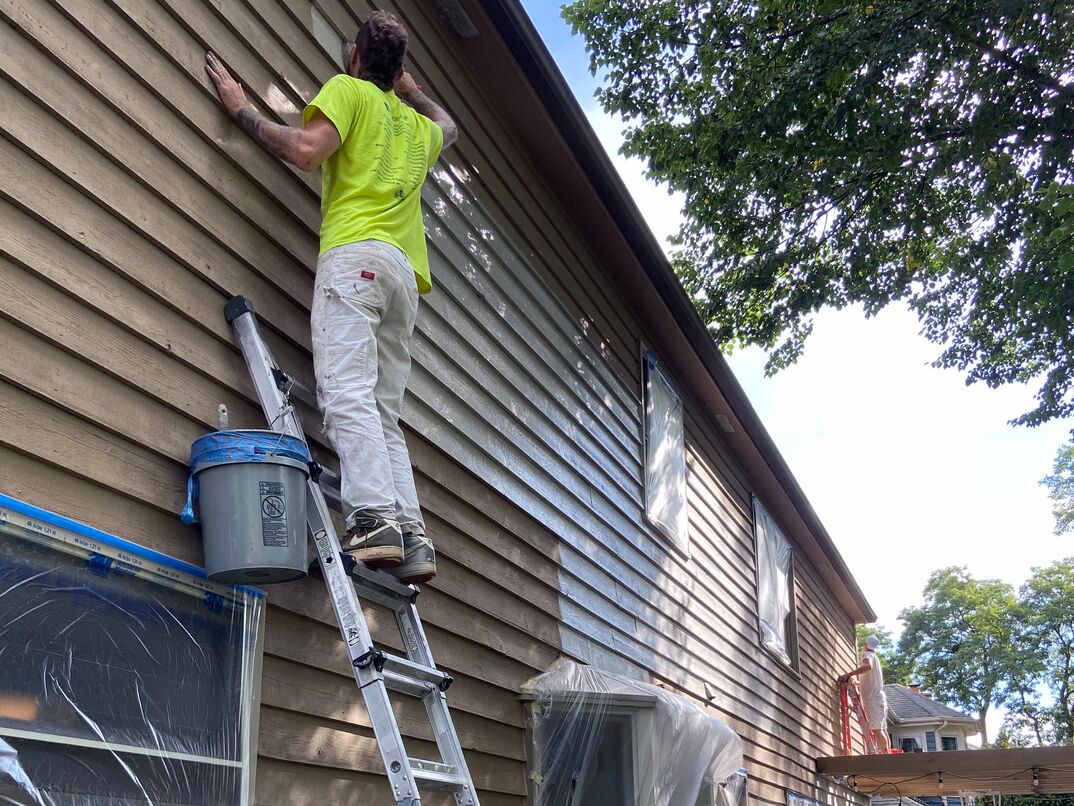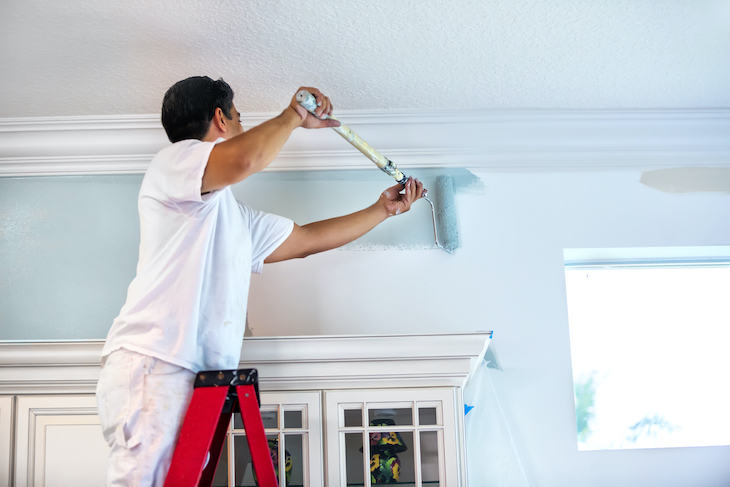Paint Your Way Home: Discover the Budget-Friendly Cost of Interior House Painting
Embarking on an interior house painting project is an exciting venture that can rejuvenate your living space. Understanding the components determining the cost of such a project is crucial for efficient budgeting, whether you’re moving into a new house or planning to renovate your current one. Wondering about the cost to paint interior of house? Our guide explains price elements to help you plan your interior painting project.
Determining Factors of Interior Painting Costs:
Size and Complexity of the Project:
When calculating the cost of painting a house’s interior, the project’s size and complexity must be considered. Larger spaces with more rooms, walls, ceilings, and trim require more time and materials. Additionally, the height and architectural intricacy of the ceilings and the presence of multiple levels or staircases can affect the overall cost.
Preparatory Work:
Before starting the actual painting process, certain preparatory work is often necessary to achieve a flawless result. This may include repairing and patching damaged walls, filling cracks, holes, and imperfections, and sanding and smoothing surfaces. If there is existing wallpaper or multiple layers of paint, their removal may also be required. These preparatory tasks can influence the overall cost of the project.
Type and Quality of Paint:
The type and quality of paint you select can considerably impact the cost. Basic paint options are more affordable, while premium brands may come at a higher price. Additionally, the number of paint coats required to achieve the desired finish will affect the overall cost. Furthermore, the chosen paint finish, such as matte, eggshell, satin, semi-gloss, or gloss, can influence the pricing.
The Complexity of Color Schemes:
The complexity of the color scheme you envision for your interior can also impact the overall cost. Using multiple colors, creating intricate designs and patterns, or incorporating accent walls will require more time, effort, and materials, increasing expenses.
Additional Services:
Various additional services may be required during an interior painting project. These services can include moving furniture and covering it for protection and covering and protecting floors, windows, and fixtures. Additionally, the removal and reinstallation of switch plates, outlets, and other hardware may be necessary. These additional services contribute to the overall cost of the project.
Average Cost Estimates:
Cost Per Square Foot:
The cost to paint the interior of a house is often estimated on a per-square-foot basis. Interior painting costs range from $2 to $6 per square foot. Basic paint jobs with a single coat and minimal surface preparation tend to fall on the lower end of the spectrum. However, more complex jobs that require numerous colors, detailed drawings, or specialist finishes will cost more.
Professional Labor Costs:
Hiring professional painters is a popular choice for ensuring high-quality results. Professional labor costs typically range from $20 to $50 per hour. The hourly pricing may be influenced by the project’s complexity, location, and the contractor’s experience. Some specialists may also charge a fixed price based on the project’s magnitude.
Additional Expenses:
Aside from labor expenditures, there are various other expenses to consider. These include the expense of primer, which normally varies between $15 and $30 per gallon. The type and quality of paint you select will also impact your budget, with high-quality paint costing between $25 and $70 per gallon. The cost of brushes, rollers, trays, and other painting equipment can vary from $20 to $100. Furthermore, tarps, masking tape, drop cloths, and protective materials may cost approximately $50 to $200.
Cost Examples:
Small Apartment or Room:
For a small apartment or room of around 300 square feet, the cost to paint the interior can range from $600 to $1,800, depending on the mentioned factors.
Average-Sized House:
For an average-sized house of approximately 2,000 square feet, with three bedrooms and two bathrooms, the cost to paint the interior may range from $4,000 to $12,000, depending on various factors.
Large Luxury Home:
For a large luxury home spanning around 5,000 square feet, with high ceilings, intricate designs, and multiple colors, the cost to paint the interior could range from $15,000 to $40,000, considering the complexity of the project and the premium finishes involved.
Ways to Reduce Costs:
DIY Painting:
One effective way to reduce costs is by taking on the painting project yourself. By doing so, you eliminate professional labor costs. However, remember that DIY painting requires time, effort, skill, and attention to detail.
Comparing Multiple Quotes:
It is essential to obtain detailed quotes from different professional painters and compare their rates and services. Ensure that the estimates include all necessary aspects of the project, such as surface preparation, the number of paint coats, and any additional services required.
Opting for Standard Paint and Finishes:
Choosing standard paint options and finishes can help keep costs under control. Premium brands and specialized finishes can significantly increase the overall cost. Opting for more affordable paint options that still provide satisfactory results can be a smart, budget-conscious decision.
Proper Maintenance and Longevity:
Properly caring for your painted interior can prolong its lifespan, reducing the need for repainting soon. Regular maintenance, such as cleaning walls and promptly addressing minor touch-ups, can help preserve the appearance and extend the paint job’s life.
Conclusion:
When considering painting the interior of your house, understanding the factors contributing to the overall cost is crucial for effective budgeting. You can estimate the expenses by considering the size and complexity of the project, the preparatory work involved, the type and quality of paint, the complexity of color schemes, and any additional services required. While professional labor costs are a significant portion of the budget, exploring options such as DIY painting or opting for standard paint and finishes can make the project more affordable. You can achieve a fresh and vibrant interior within your desired budget with proper planning and attention to detail.
FAQS
Q: How is the cost to paint the interior of a house determined?
A: The cost to paint the interior of a house is determined based on factors such as the size of the area to be painted, the number of rooms, the condition of the surfaces, the type of paint and finishes desired, and any additional services required, such as repairs or surface preparation.
Q: What is the average cost to paint the interior of a house?
A: Factors that affect how much it costs to paint a home’s interior include its location, its size, the intricacy of the project, and the quality of the materials utilized. A professional interior paint job typically costs between $2,000 and $5,000.
Q: Do painters charge per room or per square footage?
A: Painters may charge per room or square footage depending on their pricing structure. Some painters charge based on the square footage of the area to be painted, while others provide a package price for each room.
Q: Does the paint color affect the cost?
A: The paint color chosen for the house’s interior typically does not affect the cost. Size, surface quality, and the need for ancillary services are the common factors that influence overall costs.
Q: Are the costs of materials included in the painting quote?
A: In most cases, the cost of materials, including paint and other necessary supplies, is included in the painting quote provided by professional painters. However, clarifying this with the painter before hiring them is important.
Q: Are there additional costs beyond the painting itself?
A: Additional costs may include wall repairs, patching holes, surface preparation, priming, removing old wallpaper or paint, and any special finishes or techniques requested. These services are often charged separately from the basic painting cost.
Q: Should I choose the cheapest painter to save money?
A: While price is a consideration, it’s important to also consider the painter’s experience, reputation, and the quality of their work. Opting for the cheapest painter may result in subpar workmanship or the use of low-quality materials, which can affect the overall outcome.
Q: How can I get an accurate estimate for the painting project?
A: To get an accurate estimate, scheduling an on-site visit with professional painters is recommended. After evaluating the project and considering all relevant elements, they will give you a comprehensive quote tailored to your needs.
Q: Can I save money by painting the interior myself?
A: Painting the interior yourself can save money on labor costs, but it requires skill, time, and effort. It’s important to consider your own capabilities and whether you have the necessary tools and expertise for a high-quality paint job.
Q: Should I get multiple quotes before hiring a painter?
A: It is generally advisable to obtain multiple quotes from different painters. You can then make an educated decision based on your needs and budget after comparing rates and examining the quality of the work and materials on offer.
Q: What is the average price of interior house painting?
A: Factors that affect how much it will cost to paint a home’s interior include:
- The square footage of the house.
- The number of rooms.
- The quality of the surfaces to be painted.
- The desired paint color and finish.
- The home’s location.
A professional interior paint job typically costs between $2,000 and $5,000. A project’s final price tag could be significantly more or lower than this range indicates for various reasons. To get a more accurate estimate, it’s recommended to consult with professional painters in your area who can assess the project and provide a personalized quote based on your requirements.








